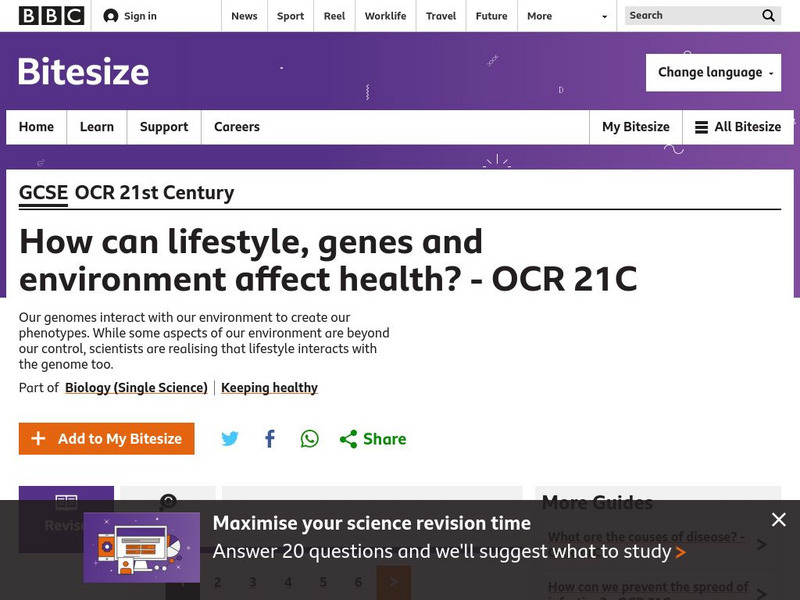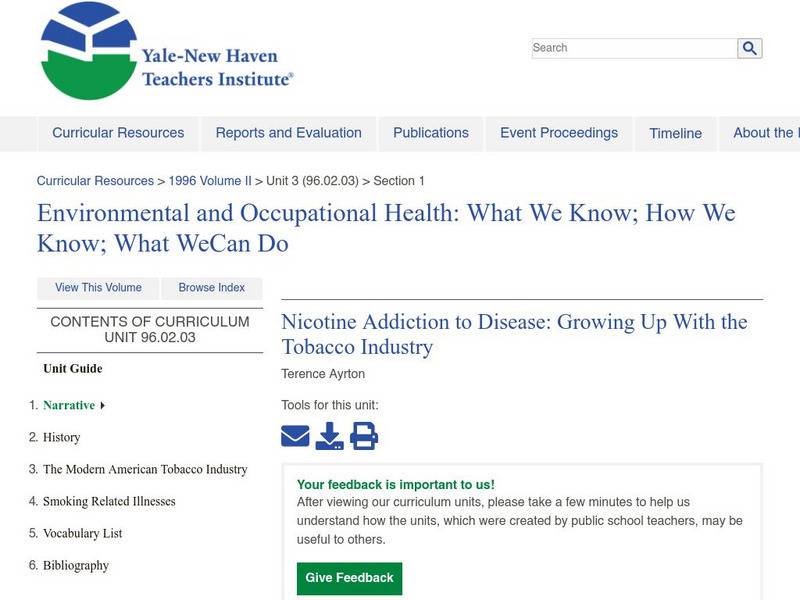Hi, what do you want to do?
Curated OER
Here's To Your Healthy Heart!
Students examine the primary controllable and uncontrollable factors that put one at greater risk for developing heart disease. Through discussion, research, physical tests, and questionnaires they determine whether or not they are at...
Curated OER
Heart Alert
Explore some of the causes and preventions of heart disease. Young learners play a game of tag in which the taggers role play as risk factors for heart disease. Players who are tagged call out "heart alert" and are saved when someone...
Curated OER
Brushing Teeth Halts Heart Disease
Ninth graders examine the causes and effects of Heart Disease. In this ESL Current Events lesson plan, 9th graders read an article on Heart Disease. Students complete guided questions on the reading.
Curated OER
Effects of Lung Disease
Students illustrate the chronic lung conditions associated with smoking and write a persuasive argument against smoking. In this lung disease lesson, students use straws and balloons to illustrate the problems created by smoking. They...
Curated OER
Noncommunicable Diseases
In this noncommunicable diseases worksheet, students determine which diseases are not caused by pathogens and where a tumor is located. Then they describe a chronic disease that has a faulty immune system. Students also identify what...
Curated OER
Heart Fair
Students demonstrate their knowledge of the heart and heart disease by creating and presenting a project at the annual Heart Fair. They design a booth for the Heart Fair and inform people of how to have and maintain a healthy heart.
Curated OER
Lung Disease
Learners simulate breathing for a smoker and someone with a chronic lung disease. In this health science lesson, students examine the short and long term effects of smoking. They write a persuasive argument against it.
Curated OER
What Does Advertising Say About Smoking?
Students analyze the decision to smoke and how it is influenced by peer pressure. The discuss ways to say no to tobacco use.
Curated OER
Healthy Hearts
Learners research the basic concepts of heart health and disease and become an expert in an area as it relates to the heart and circulatory system. They prepare a multimedia presentation of their findings.
Curated OER
Making Choices about Tobacco Use
Students examine the dangers associated with smoking. In groups, they discuss what it means to be addicted to a drug and how the media influences our decisions. After watching excerpts of films, they identify the use of smoking and the...
Curated OER
Drugs and Safety Precautions
Drugs can both help and harm depending on how they are used. Fifth graders complete a worksheet that provides background information on prescription drugs. They read the text and then describe why medication manufacturers label pill...
Curated OER
World Heart Day
In this World Heart Day activity, students complete activities including reading a passage, matching phrases, fill in the blanks, correct word choosing, multiple choice, sequencing, unscramble the sentences, write questions, take a...
Curated OER
Risky Business worksheet
In this health worksheet, students interview friends and family to see what risky health factors they have. Students interview 5 people about 6 risky factors each.
American Heart Association
American Heart Association: Smoking & Cardiovascular Disease (Heart Disease)
Learn the risks of smoking and how it causes cardiovascular disease. The article includes the risks and health effects of smoking, information on secondhand smoke, and resources and tools for kicking the habit.
Government of Canada
Health Living: Smoking Diseases
Learn about all the different diseases you can get by smoking. Smoking increases your chances of heart disease, smoke, and lung cancer, to name just a few. Find out the link between impotence and smoking, as well as to bronchitis and...
Other
Story md.com: Cardiovascular Continuum
The significance of the cardiovascular continuum is its emphasis on prevention. By treating risk factors that occur early in the cardiovascular continuum, like hypertension, diabetes, high blood fat levels, and smoking, it may be...
Texas Heart Institute
Texas Heart Institute: Heart Information Center: Heart Disease Risk Factors
One-page article answers questions about heart disease risk factors in children and teenagers including high blood pressure, cholesterol, smoking, obesity, and physical inactivity.
The Franklin Institute
The Franklin Institute: Heart Health and Care
This is a simple guide from The Franklin Institute to keeping your heart healthy through proper exercise, a varied diet, and a clean lifestyle. Here, read about how to exercise and eat to avoid heart disease.
BBC
Bbc: Gcse Bitesize: How Can Lifestyle, Genes and Environment Affect Health? Oc
This lesson focuses on Cardiovascular disease. The heart requires its own constant blood supply in order to keep beating and this is delivered through the coronary arteries. Genetic and lifestyle factors can lead to the coronary arteries...
Centers for Disease Control and Prevention
Centers for Disease Control: Bam! Your Body: Operation: Flame Out!
Tells the story of how, as tobacco became more popular, it changed human health, and what the CDC did to fight the epidemic.
Mayo Clinic
Mayo Clinic: Secondhand Smoke
Use this site to learn why a "Burning cigarette is a health risk to everyone in the same room." This web-article describes the various hazards associated with secondhand smoke and includes information on its effect on children. Also,...
WebMD
Web Md: Health News
WebMD is a very helpful online health resource. Coverage includes the latest health & medical news, with in-depth medical references at your fingertips. Topics that range from diabetes to second hand smoking are discussed by medical...
Aetna Intelihealth
Aetna: Inteli Health: Secondary Hypertension
This resourcecontains a thorough overview of secondary hypertension. There is also information on symptoms, prevention, treatment, and more.
Yale University
Yale New Haven Teachers Institute: Nicotine Addiction
From the Yale-New Haven Teacher's Institute, comprehensive history of tobacco, the tobacco industry, and tobacco-related illnesses.


























